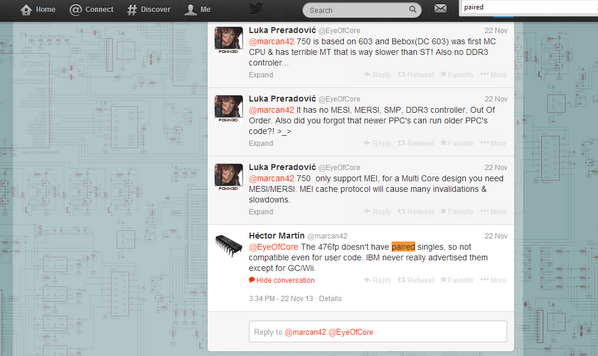"
nope, you just confirmed what i said, ibm modified the old 750cxe so that gekko could support paired singles and could have done the sqae to the 476fp fpu
marcan said that 476fp doesnt support paired singles and that would have been an obstacle, clearly teh guy hadnt read ign report from IBM tech experts
HE DOESNT NEED TO READ GARBAGE REPORTS FROM MORONIC GAME JOURNALISTS, HE KNOWS EVERYTHING THAT GOES ON IN THE GEKKO AND THE BROADWAY. ITS ALMOST LIKE HES THE PERSON WHO HACKED THEM OR SOEMTHING. OF COURSE HE ALREADY KNOWS THAT INFORMATION. EVERYBODY ALREADY KNOWS THAT INFORMATION. HE WAS THE FIRST ONE TO SPECIFICALLY TELL YOU IT WAS A FEATURE CUSTOM DONE TO NINTENDO FOR THE GAMECUBE.
You are holding onto a worthless pile of nothing, as if it were some golden terd of salvation dangling out of Jesus' butt cheecks. Its not, its nothing. EVERYBODY who has EVER seriously discussed nintendo hardware for the past DECADE knows about that, to the point it is old information no longer needed to even be brought up... EXCEPT FOR YOU.
Attaining backwards compatability via attempting to 'broadwaify' another, completely different architecture, that was already weaker than what they could do with the chip that already had 100% perfect backwards compatability is just. Its stupid. And the fact you keep bringing it up over and over and over, and posting these links you clearly dont understand, that do nothing whatsoever, over and over and over again. Never stopping, never changing, never gfazed no matter how many times you are blatantly proven wrong, you kust keep posting made up crap after made up crap.
This is enough.
Come back again after you get some self control Eye of core. I have been MORE than patient with you.
nope, you just confirmed what i said, ibm modified the old 750cxe so that gekko could support paired singles and could have done the same to the 476fp fpu
marcan said that 476fp fpu doesnt support paired singles and that would have been an obstacle, clearly teh guy hadnt read ign report from IBM tech experts about what they did on gekko and so they could also have done to the 476fp fpu
please understand, the answer is not just in the ign interview, but also in the users manual you will see later
http://www.ign.com/articles/2001/12/13/interview-ibm-details-gekko-part-i
"
Interview: IBM Details Gekko (Part I)
Two of the main designers behind GameCube's Gekko CPU give new insights in this IGNcube interview.
by IGN Staff
DECEMBER 12, 2001
IGNcube: Were you both involved with the design of Gekko?
IBM, Mike West:
Yes we were. I'm actually a multimedia architect. My background is graphics and multimedia, and I've been working closely with Nintendo for -- probably -- it's got to be close to four years now. And Pete, he is our lead PowerPC architect who actually worked on the detailed architecture of the Gekko chip for the changes we made, over and above the PowerPC architecture. So Pete led the [design] of the actual chip architecture and I worked with Nintendo across the system.
IGNcube: There's a sort of general conception that Gekko is just a basic PowerPC 750 and IBM didn't really modify the core that much. Is there anything you would say to dispel that conception?
IBM, Mike West:
There have been some recent articles on the web that have that view, which is a little surprising. We presented a lot of details at Hot Chips and the Embedded Processor Forum, both public domains. But, Gekko is a lot more than just a PowerPC 750 and it is an integral part of the system.
IBM, Peter Sandon:
Nintendo came to us and said, "Here's what we need for a graphics system. We need FPU (floating point) performance beyond what will be built into the graphics chip itself and we need to move data." So the main things we concentrated on where those two: moving data through the system as it's processed and a high level of floating point performance in order to do some of the things one might expect are done on the graphics chip, but in order to do more custom kind of lighting and geometry and so-forth that can't be done in some of the fixed-function graphics pipeline on the graphics processor, we enhanced our floating point performance.
IGNcube: At the Embedded Processor Forum it was said that Gekko was used for the "close-up lighting in Luigi's Mansion." What kind of assistance does Gekko provide with that and other graphics functions?
IBM, Peter Sandon:
Well it basically does the local lighting calculations. The lighting that's implemented in the graphics chip is for lights at infinity. So, if you want to get the effects that you get from so-called local lights that don't look like they're out at infinity, those calculations are done on Gekko.
IGNcube: How much flexibility does Gekko have to assist in these kinds of graphical functions? How hard does it hit the processor when you start doing something like that.
IBM, Mike West:
You have to understand what's done with the floating point unit. It is the conventional 64-bit PowerPC floating point unit, but the adaptations we made to it allow two simultaneous 32-bit calculations to occur. Basically each instruction is completed every cycle.
IBM, Peter Sandon:
Right, and I should say that it is a significant effort to implement the paired-single floating point function beyond what is there in the standard PowerPC.
"
And Is not like IBM had to start from the scratch, just take the fpu from broadway and put it and adjust it on the 476fp
Still beleive they would be incompatible?
here, ask IBM
"
Programming Model Differences of
the IBM PowerPC 400 Family and
600/700 Family Processors.
Abstract – This application note describes how the programming models differ between the IBM
400 family and the 600/700 family of PowerPC architecture processor implementations. It is
useful to system designers and programmers porting code from one family to another.
The 600/700 family is compliant with the original PowerPC processor architecture designed for
desktop applications.
The 400 family, designed for use in embedded environments, maintains
compatibility in the base User Instruction Set architecture. However, it defines separate Virtual
Environment and Operating Environment architectures that have been enhanced for embedded
applications. These optimizations have prompted changes in features such as memory
management, debug support, and cache access and control, and processor extendibility.
12 Conclusion
The PowerPC Architecture provides a high degree of code portability between different implementations
even when the implementations have significant differences in their intended applications. Porting code
between implementations is a straightforward and manageable job that is primarily limited to the kernel
and other supervisory mode code. Applications typically require almost no changes in order to be moved
to a different target processor than that which they were originally developed for.
Porting between processors can be greatly facilitated by the use of structured programming methods,
which then minimizes the amount of code needing modification. For example, if all access to the Time
Base is done using a single function which is used by the entire application and operating system, only
that function needs to be modified when porting to another PowerPC processor.
"
your attempts are useless, you may have marcan, but I have IBM, and if marcan says something that goes against IBMs words then something is fishy
Edited by megafenix, 03 December 2013 - 04:47 PM.





 This topic is locked
This topic is locked











